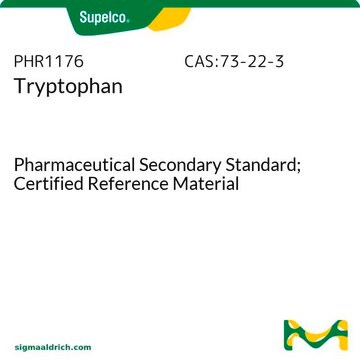1.08374
L-Tryptophan
for biochemistry
Synonym(s):
L-Tryptophan, Trp
About This Item
Recommended Products
Quality Level
form
solid
potency
16000 mg/kg LD50, oral (Rat)
pH
5.5-7.0 (20 °C, 10 g/L in H2O)
mp
290 °C (decomposition)
solubility
10 g/L
bulk density
400 kg/m3
storage temp.
2-30°C
InChI
1S/C11H12N2O2/c12-9(11(14)15)5-7-6-13-10-4-2-1-3-8(7)10/h1-4,6,9,13H,5,12H2,(H,14,15)
InChI key
QIVBCDIJIAJPQS-UHFFFAOYSA-N
Related Categories
Application
- Biotechnological production of L-Tryptophan: The study by Nefedova et al. explores the molecular mechanisms in metal oxide nanoparticle interactions with L-Tryptophan, highlighting its significance in nanoparticle synthesis, which is crucial for biotechnological applications in pharmaceutical manufacturing and life sciences (Nefedova et al., 2024).
Analysis Note
Identity (IR-spectrum): passes test
Identity (specific rotation): passes test
Spec. rotation (α 20/D, 10 g/l, water, calc. on dried substance): -30.0 to -33.0
Appearance: white to almost white, crystalline or amorphous powder
Appearance of solution (10 g/l, Hydrochloric acid 1 mol/l): clear and colorless
Chloride (Cl): ≤ 200 ppm
Sulfate (SO₄): ≤ 300 ppm
Fe (Iron): ≤ 20 ppm
Ninhydrin-positive substances (LC)(any ninhydrin-positive impurity): ≤ 0.2 %
Ninhydrin-positive substances (LC) (ammonium (570 nm)): ≤ 0.02 %
Ninhydrin-positive substances (LC)(total impurities): ≤ 0.5 %
Loss on drying (105 °C; 3 h): ≤ 0.3 %
Storage Class
13 - Non Combustible Solids
wgk_germany
WGK 1
flash_point_f
Not applicable
flash_point_c
Not applicable
Certificates of Analysis (COA)
Search for Certificates of Analysis (COA) by entering the products Lot/Batch Number. Lot and Batch Numbers can be found on a product’s label following the words ‘Lot’ or ‘Batch’.
Already Own This Product?
Find documentation for the products that you have recently purchased in the Document Library.
Customers Also Viewed
Our team of scientists has experience in all areas of research including Life Science, Material Science, Chemical Synthesis, Chromatography, Analytical and many others.
Contact Technical Service







